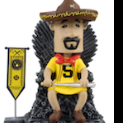
Brewers Video
In yesterday’s installment of this series, a frequent theme was the irreducible uncertainty about whether any particular adjustment would help Christian Yelich regain his former glory at the plate. It’s hard to pin down precisely what is wrong, which makes it doubly difficult to identify any remedies. I’m happy to report that we’ll have no such difficulties this time. {Alas. The monkey’s paw curls.}
For William Contreras, the defensive shortcomings aren’t subtle, layered, commingled or opaque. They’re obvious, and the fixes for them are pretty well-known and well-understood, too. The huge, looming question is whether the young slugger is capable of implementing those changes. We know what the rest of baseball thinks, because if there were many teams who believed the answer to be ‘yes,’ Contreras would not have been available for the bargain price of rookie outfielder Esteury Ruiz.
Nor can you blame teams for their skepticism. Contreras, 25, has been a catcher for his whole professional career. He has a big-league older brother who plays the position, and who has the same weaknesses in his game. It’s reasonable to think that if Contreras were going to make major strides as a receiver, pitch framer, and handler of pitching staffs, he would have done it by now. The obviousness of the flaws in his defensive game argues against the idea that he simply hasn’t noticed them, and the fact that he’s been unable to resolve them in over a half-decade of work argues against the notion that he’s going to do so at all.
Ah, but the Brewers have a secret weapon–or, rather, three of them. In catching instructors Charlie Greene, Nestor Corredor, and Walker McKinven, they have a triumvirate they think can help Contreras defy the industry’s expectations and take a forward leap, like a handful of other backstops have over the last half-decade. Let’s take a look at how they can do it.
First and foremost among Contreras’s faults as a receiver is his framing, and that has everything to do with his setup and mechanics. Compare this clip of him losing a should-be strike:
To this one, of Sean Murphy stealing a strike instead:
A few differences should jump out right away. For one, note the knee on which each is set up. Both guys were calling an inside sinker to a right-handed batter. For that offering, you want to have your left knee down and your right up, as Murphy does. That gives the umpire (operating in a tight space, perched between the batter and the catcher and watching the ball come right down that lane) a good look at the pitch. Contreras, however, sets up with the right knee down. (More on that shortly.)
That's an easy fix. It's about attention to detail, and no catching gurus in MLB sweat that particular small stuff better than Greene, Corredor, and McKinven. It's just the tip of the iceberg, though. Contreras also fails to trust his hands and anticipate the pitch. In the style of framing he uses, the idea is to drop your mitt, track the pitch in flight, then meet it with a smooth action. If done correctly, this can make a pitch that barely nips the edge of the zone (or entirely fails to) look like a clear strike. Here's José Trevino doing it perfectly, even on a pitch that missed his target by the full width of home plate:
For clearer contrast, here's Contreras again, dealing with a similar pitch and location, but failing to match the movement or the result Trevino effected.
The mistakes Contreras made on these two pitches aren't the same. On the first, there's a hitch. He starts raising his glove too soon, and goes too far. Thus, he has to dip back down for the ball, making it look less like it caught the bottom of the zone. On this one, the error lies in waiting too long. He lets the ball get through the hitting zone and to his mitt before he starts coming up to meet it. The difference between doing this right and doing it wrong can be infinitesimal. Contreras was just late in his movement. It's a tiny thing that the best catchers consistently execute correctly, though.
Fixing this issue is harder than fixing the setups. Teaching that anticipation--the familiarity it requires with the nuances of each pitcher's stuff; the delicate timing; and the forceful but fluid movement itself--is hard. It can be done, though, and Greene, Corredor, and McKinven have managed it before. The trio have been working exhaustively with Contreras already this spring, and it's a safe bet that these have been points of emphasis. In fact, you don't have to bet. We know for sure, from watching these clips.
Charlie Greene, Walker McKinvin and Nestor Corredor going to get this guy ready to lead @brewers staff. Athletic, strong looking dude is @Wcontreras42
— Vinny Rottino (@VinnyRottino) February 17, 2023
Video courtesy of @NicoleSedivy pic.twitter.com/cH8mvFaQju
That leaves one more major problem, perhaps the toughest to address with regard to framing. Contreras's setup, regardless of on which knee, just wasn't balanced or flexible enough last season. Here's one more video of him losing a potential strike. This time, look especially at the distribution of his weight, and on the way he moves when the ball doesn't go where he and his pitcher had wanted.
Look at the left leg here. It's outside Contreras's physical frame. His right leg is a little bit out from under him, too, on the other side, but the left leg is a bigger problem. He can't stay balanced out of this position. He can't move smoothly and powerfully, especially when a pitch misses its spot. Because of the way that left leg crowds his left elbow, in fact, he couldn't even have physically managed the proper movement on this pitch, which would have been to slide but not turn the glove and catch it low and strong.
This problem plagued Contreras for much of the season. Go back and compare his setups to those of Murphy and Trevino. This isn't a size problem; Contreras isn't a huge guy for the position. What he needs to do is become more flexible and functionally strong, so that he can keep his legs active and underneath him, even in one-legged crouches. (In the tweet video of his spring work, we see that the Crew have already been working with him on that very thing.)
The good news is that he is, at least infrequently, already capable of that. Let's finally give the man a break, and show a strike he stole for his Atlanta teammates.
This frame job has everything. He anticipates the pitch, and catches it smoothly. He's able to do that because his setup was more compact and agile. That's all within his reach, and Greene, Corredor, and McKinven will try to help him do it more often throughout this spring.
Once the team heads north, of course, Greene will fall away from daily instruction, and McKinven and Corredor will be tasked with much of the maintenance of whatever adjustments they collaborate to create during spring training. That's a whole different challenge. A former pitcher, McKinven has put in tireless hours of focus on the very fundamental building block we discussed first: setups. He'll be able to remind and drill Contreras on how to set up for various pitches, based on the situation, the pitcher, the handedness of the opposing batter, and more. Corredor, one of the team's bullpen coaches, should be able to provide some occasional tips in the other two aspects, but there will be little time for those drills, anyway. By March 30, Contreras's major framing improvements for the year need to be largely locked in.
Thereafter, McKinven, Chris Hook, and Jim Henderson will need more of Contreras's time, for the purpose of helping implement the team's complex run prevention plans. It was shocking, in watching the videos above and so many more from last year, how rough was Contreras's feel for the vital details and utility of his pitchers' repertoires during much of last season. He'll have to have a better handle on the Brewers hurlers if he's going to be the primary catcher this year.
None of this is to mention that Contreras is also being counted on as one of the anchors of the team's lineup. He might get some run as a designated hitter, if Victor Caratini's bat and Jesse Winker's glove make that feasible, but the team needs him to produce at the plate, even as he takes on a formidable challenge to become a better defender at the most important position on the diamond. Greene, Corredor, and McKinven will do plenty for him, but the range of possibilities for Contreras is still wider than for just about any similarly important Brewers player in recent memory.
Think you could write a story like this? Brewer Fanatic wants you to develop your voice, find an audience, and we'll pay you to do it. Just fill out this form.
MORE FROM BREWER FANATIC
— Latest Brewers coverage from our writers
— Recent Brewers discussion in our forums
— Follow Brewer Fanatic via Twitter, Facebook or email
-
 1
1










Recommended Comments
Join the conversation
You can post now and register later. If you have an account, sign in now to post with your account.
Note: Your post will require moderator approval before it will be visible.